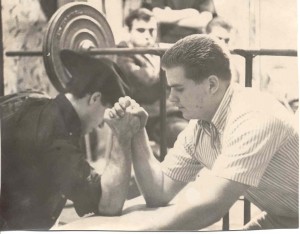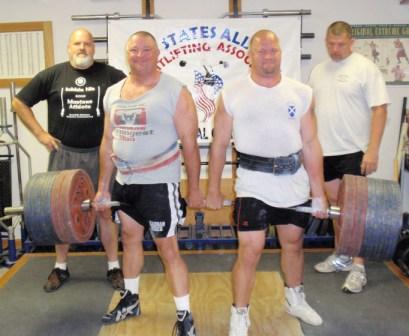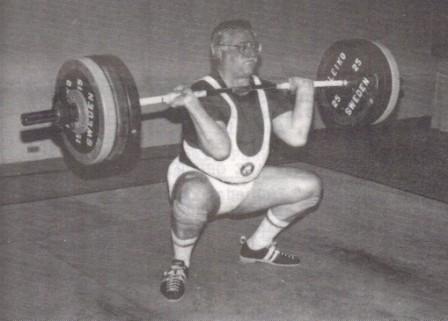by Thom Van Vleck

Phil Jackson (R) arm wrestling in the old JWC gym
A lot of you guys hear me mention my “Uncle Phil” and a few of you have asked me to tell you more about him (some of the old timers still around like Bill Clark, Charles Scott, and Wilbur Miller will remember him personally) . He is Phil Jackson and he’s the one really responsible for the Jackson Weightlifting Club today. He is also the source of most of my training knowledge. He has been a father figure, a friend, an mentor, a coach, and sometimes agitator! The photo above was when Phil was just a teen. He was a fantastic arm wrestler and says he was NEVER beaten and I can find no one who says they did! Phil’s main passion was Olympic lifting and Bodybuilding. He had a disdain for powerlifters calling them “Olympic lifting rejects”, but that was mostly good natured (at least I think it was!).
My grandfather initially started the JWC in 1928 with his brother in law, Coda Baugher, and some friends. But to be honest, this was just some neighborhood friends hanging out and lifting weights and it quickly broke up as they grew up and left home. However, my grandfather would tell the stories to my Uncles and they started lifting in 1957. Initially, it was my Uncle’s Leroy and Wayne. Phil was the “baby” of the family and started a couple years later.
Leroy was a star athlete and interested in weights only to benefit his other interests in football, basketball, baseball, and track and he was very successful in those sports. But Wayne took an interest in Olympic lifting and entered his first contest in April of 1962 (run by Bill Clark) and out of that, the modern JWC was born! Phil was always the “go getter”, the guy that would pull everyone together to train, compete, and put up money for contests. He soon rounded up over 30 members to the newly named JWC and fielded teams that traveled to dozens of meets across the Midwest during the 60’s. During that time, the JWC won two team state championships in Olympic lifting against teams from St. Louis and Kansas City. Phil lifted on those teams but he was always the “coach” and main motivator. Phil has always been an “old school” type coach. If he thinks making you mad will make you better….prepare to be madder than you’ve ever been. Phil knows how motivate people, one way or the other!!!! He used his coaching lessons later in life to win 42 out of 42 consecutive sales awards during his career as a sales manager for a large insurance company.
In 1965 Phil earned a unusual distinction. That year he entered the Missouri High School State Championships in Olympic Lifting, held in Kansas City that year. At that time Phil was around 17 years of age and he lifted either 165lbs or 181lbs. He became adept at making weight when he had to. He had an ongoing battle with another lifter and Phil was going to make a point of beating him at this meet. He thought this fella was going to lift in the 165lb class so Phil (already with a qualifying total in another meet at 165) cut weight and showed up to lift on the first day. That day, the 114lb, 123lb, 145lb, and 165lb classes were due to lift on Saturday. The other guy found out about this and gained up to lift 181lbs obviously trying to avoid the confrontation. Phil lifted 165lbs and won, but the other guy started talking some trash about how he was “lucky” Phil had avoided certain defeat had he entered that class. So Phil showed up on Sunday to weigh in, having hit the buffet and downing a gallon of milk to make the 181lb class.
Phil had a qualifying total at 181 and stated he wanted to lift. The officials told he he couldn’t and Phil said, “Show me in the rules where it says I can’t”!! The officials couldn’t find any rule so decide to let him lift….much the the chagrin of his “rival”. Phil hit the exact same total as the previous day and won! Two state titles in two weight classes…..the same YEAR! The following year, the AAU made a rule explicitly forbidding anyone from doing that again. While no one named Phil as the reason for the rule….it always seemed there had to be a connection. Later, all other lifting organizations, as they developed, lifted that rule from the AAU rule book and today it’s standard in all lifting organizations.
In March of 1966, Phil was going to be drafted so he joined the Air Force. He was soon after sent to Vietnam for a year where he poured himself into his training as an escape and got into the best shape of his life. When he came back from Vietnam he was stationed in Alabama where he met and trained with greats such as Joe Dube, Frank Zane (although Phil always called him “chicken legs Zane”), Boyer Coe, Casey Viator, and Karo Whitfield to name a few. He also met and had a long personal conversation with Paul Anderson during this time.
In 1969 Phil came back to Kirksville to attend Northeast Missouri State University (now Truman State) and during that time him and my Uncle Wayne achieved some of their greatest strength lifts. In 1971 Wayne won the Missouri State title in Powerlifting AND Olympic Lifting with Phil at his side pushing him the whole way. During that time he became best friends with Lenvil Elliot, a friendship that lasted until Lenny’s passing a few years ago. Lenny was a JWC member and later played 8 years in the NFL and was the MVP of the 1982 NFC Championship Game (the game where Joe Montana threw the famous pass to Dwight Clark) and Lenny won a Super Bowl ring. So, a JWC member has a Super Bowl ring!
In 1973, Phil graduated and the rigors of a family and job, plus moving away, led to him giving up heavy lifting. During that time he would always challenge himself. One time he made a goal of being able to do 100 pushups without stopping and trained for that. I often visited him and we often went hunting and fishing together and he made a point of always “showing me up” with some feat of strength or endurance. At the same time, he always let me know that if I wanted to beat him, it was as simple as being willing to “pay the price” and get stronger. Phil often reminded me, “The only time Success comes before Work is in the Dictionary”. I was always impressed with his exploits and feats of strength and it fired me up to be strong!
In 1977 I took an interest in weight training and soon Phil was my coach. Since he was my mother’s younger brother people thought we were brothers and I suppose we acted like it, cutting up all the time. Phil guided me in my early training and often stated, in his old school coach way, “I’ve forgotten more about training that you’ll ever know”. This has, to date, been a 33 year relationship that continues to this day. While he lives in Colorado and has since 1984, we talk a couple times a week. Often about many things, but weight training is a constant. I lived with him in 1988 and he trained me into the best all around shape of my life. We often debate heatedly on training, but in that process, I know he’s pushing me to become better. Over the years I’ve been out at least two dozen times for visits and he comes back almost yearly and during that time we have intense meetings on training, politics, and life.
Then, in 2000, after a 27 year absence from serious weight training, Phil made his “comeback”. Since that time he trains about 3 hours a day, usually a split routine, and often almost daily. He trains old school, long, hard hours in the gym and he has had some amazing results. I am hoping that someday I can coax him into a USAWA meet! I am confident he could break many records. But that doesn’t seem to interest him as much as just communing with the iron and using his lifting as a way of life rather than a path to glory. I can honestly say that at 60 he was in the best shape I’ve ever seen for a 60 year old man
Phil has had some bad luck as of late. Severely injuring his shoulder in a fall that required surgery and some health issues that appear to be related to his exposure to agent orange and DDT in Vietnam (he worked in a warehouse that ordered, stored, and dispersed the product and he said the area around the base was sprayed constantly). But Phil never stops, he never gives up and that’s what I’ve come to expect from him. I am currently working with him on a book about the JWC that will involve life stories along with real, hardcore, training philosophy. Even if it never gets published, I know I’m already better off from the knowledge and lessons learned in the process.
In closing, I’ll just say that what I admire most about Phil was he had the mind of a champion. Once he locked on a goal, he was unbeatable. He may not have been gifted genetically, but he would get 100% out of what he had and often beat others stronger, faster, and more athletic than he was…simply with determination!


